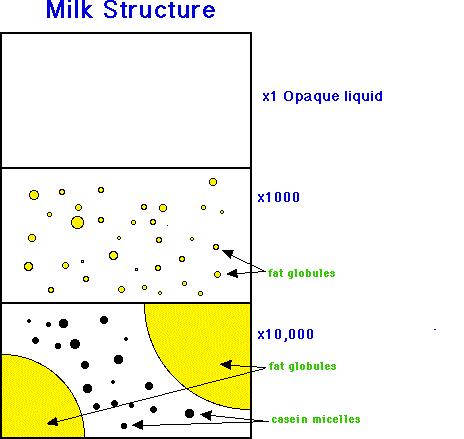Milk structure
Physically milk is an opaque, white heterogeneous fluid having various constituents in the form of emulsion, colloid suspension or solution. Fat is present as an emulsion, protein and some mineral matters in colloidal suspension and lactose together with some minerals and soluble proteins in true solution.
Ever wondered how the various constituents are present in milk? How it looks when seen through microscope? The figures below show the structure of milk as seen through microscope at different magnifications.

(Adapted from http://www.uoguelph.ca/foodscience/book-page/milk-structure)
Milk fat is present in the form of very tiny droplets ranging in size from 0.1 to 15 µm (1 µm = 1/1000 mm) in diameter (that is, 1/1000th to 1/10th times smaller than the average diameter of a strand of human hair or 1/10000th to 1/100th times smaller than the diameter of pinhead!). Further, each of these tiny droplets is covered by a thin membrane, 8 to 10 nm (1 nm = 1/1000 µm) in thickness!! The fat droplet with the membrane is called milk fat globule and the membrane is known as milk fat globule membrane. The major milk protein casein is present as small particles of 10-15 nm diameter (even smaller than the diameter of milk fat globule) called casein micelles.
Milk minus fat globules is called milk plasma or skim milk. Milk serum is milk minus fat globules and casein micelles. Whey, as you may already know, is the liquid that remains after protein is coagulated (with acid or enzymes) and removed. Unlike serum, whey may contain some of the fat globules.
(Disclaimer: The information compiled here is taken from various sources freely available and is intended for larger purpose of public information only. There is no commercial interest associated and no intention to infringe upon any rights whatsoever.)
1 A term indicating the proportion of nutrient that is absorbed from food and used for normal body functions.
2 An average adult daily diet contains 2000-3000 kcal of energy depending upon the gender, age and physical activity
3 While industrial trans fats present in hydrogenated fats are reported to be associated with negative health impacts, the trans fats of milk are either beneficial to health or harmless.
